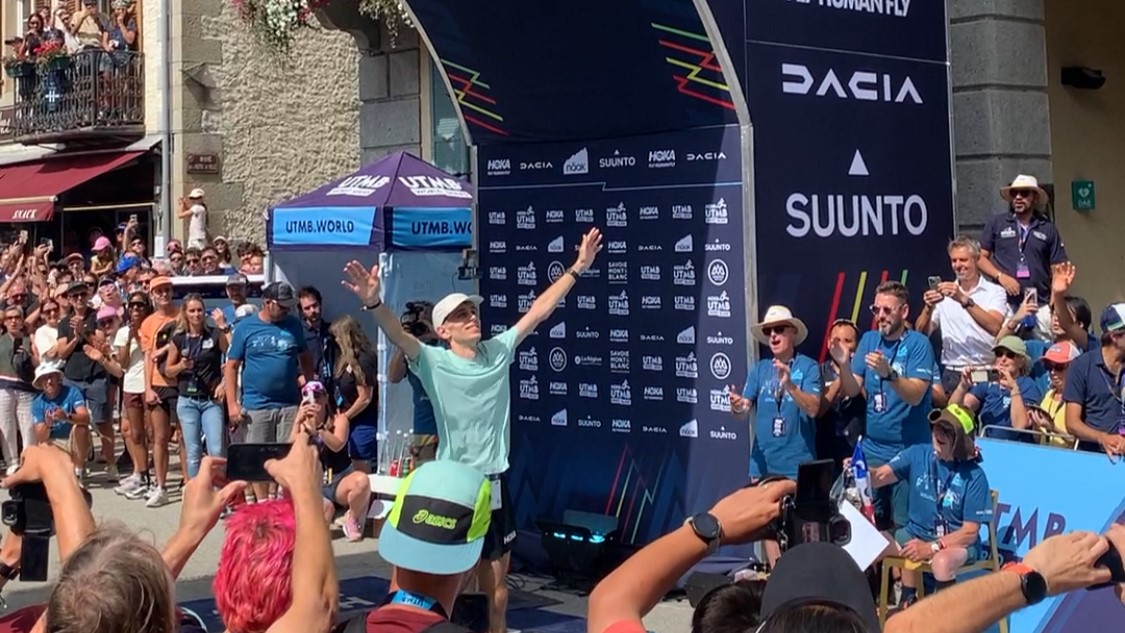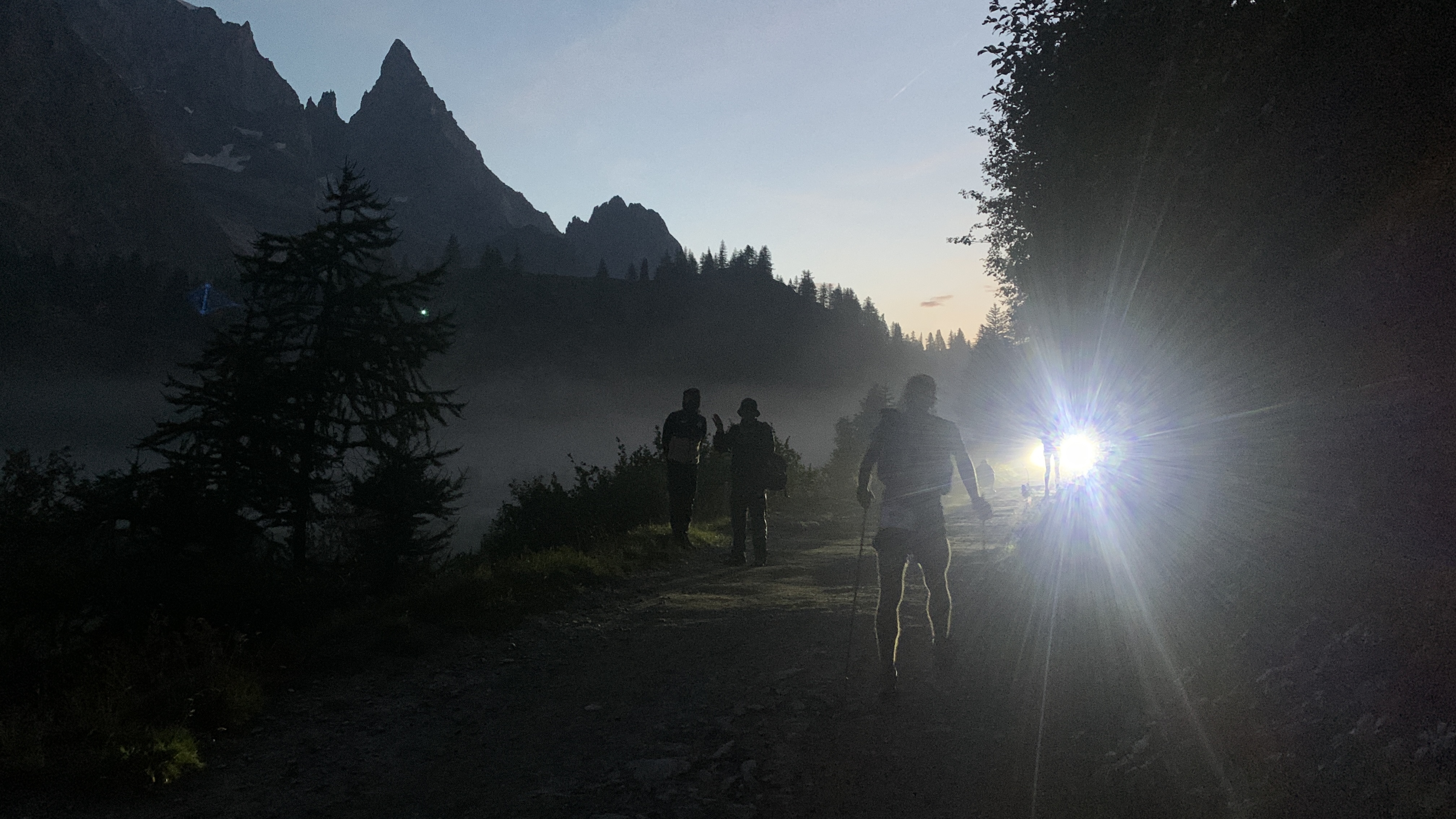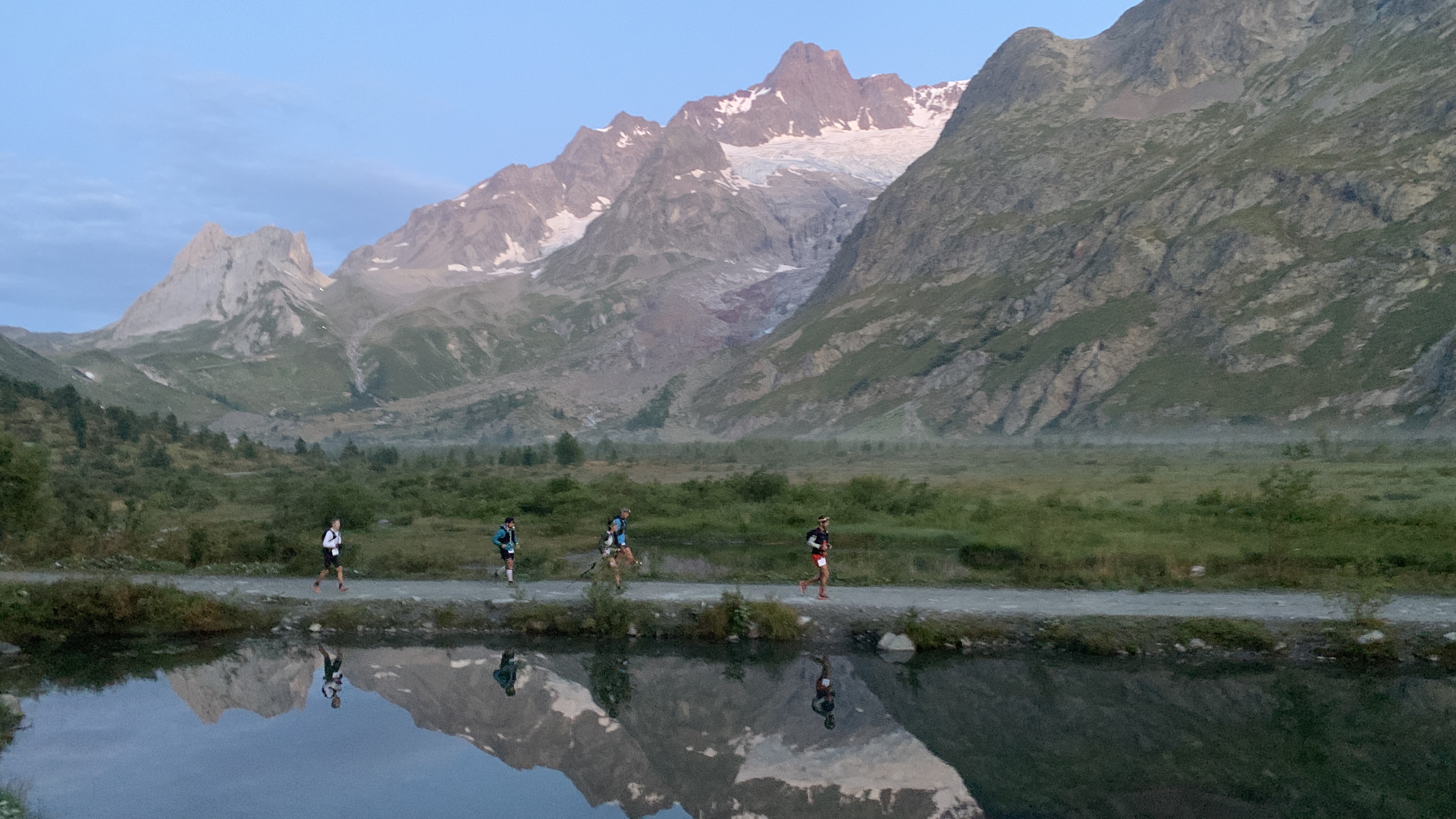
Just over a week ago, I drove up to Lake Combal in Italy at 5 a.m. with a small group of journalists. When we parked and climbed out of the van, pulling our fleece jackets on against the morning chill, we saw a long line of headlamps snaking up and down the surrounding mountains in the pitch dark for miles in either direction. These were some of the thousands of runners in this year’s UTMB, the iconic 106-mile race around Mont Blanc that is trail running’s most treasured event.
We had cheered these very runners nearly 12 hours earlier when they set off from the starting line in Chamonix, packed in with thousands of other spectators. The UTMB is a big, brazen trail running event, especially if the only part of it you experience is in Chamonix. But up here at dawn, some 70 km into the course, watching some of the most dogged runners on the planet trotting along in the peace and quiet of the Alps, powered without any applause, it’s impossible not to remember how special this race is.
This was my second year covering the race and it was more spectacular and surprising than ever. Now that I’m home and the dust has finally settled, here are seven things I learned from chasing the front runners over 22 hours at this year’s UTMB.
1. Anything can happen
I thought I had learned this lesson last year, when Jim Walmsley suddenly surged ahead well past the halfway mark and set a new record in 19:37:43, but little did I know how unpredictable this race can be, particularly on the men’s side of things.
Of course, in a race as long and difficult as the UTMB, it’s impossible to predict a winner. A hundred miles is a long time to run on a knee that has the tiniest niggle while the timing of the event can mean runners are battling extreme heat and humidity or cold and snow. But there are indicators of who’s aiming for a top 10 spot based on recent performances in similar races like the Hardrock 100 and Western States.
In this case, all eyes were on last year’s winner Walmsley, Germain Grangier who came third last year, Mathieu Blanchard who came second in 2022, Ludovic Pommeret who won the Hardrock 100 this year, Hannes Namberger who nabbed first place in the 120k Lavaredo race this year and Tom Evans who was just behind him and seeking redemption for a dispiriting DNF last year.
When I awoke at 4 a.m. after four hour's sleep to get back on the road and follow the runners through the second half of the race, however, Walmsley and Evans had already dropped out. Over the next few hours, Grangier and Blanchard followed suit. While Pommeret and Namberger did ultimately secure top 10 finishes, the podium consisted of three runners no one was betting on.
A runner few of us had even heard of, Vincent Bouillard, took the win on his first attempt at the race, becoming one of only four runners to ever complete the course in under 20 hours and leaving the rest of us frantically searching for information on him.

2. Sponsorship doesn’t guarantee a win
There’s no doubt that having a team who can crew for you and a sponsor that allows you to the financial freedom to train full-time is a huge advantage, but as this year’s race proved, it doesn’t guarantee you a win.
When Bouillard came into the Triente aid station on Saturday morning, we were still trying to figure out who he was. When we then waited 34 full minutes for the next runner to come through, we realized we were going to know a lot more about him pretty quickly, but we were still surprised by what we learned at the finish line.
Yes, Bouillard has some advantages – he lives relatively nearby and was able to train in alpine terrain and conditions. And yes, he’s a shoe engineer for Hoka, which means he not only gets access to some of the best trail running shoes on the planet, he plays a role in designing them. But he doesn't have a sponsor, he was being crewed by his partner and he works at a full-time job, which even with the best boss in the world means he can’t have put in as many training hours as some of his fellow competitors.
We’re guessing he’ll soon be sponsored if wants to be, but his victory was a refreshing reminder that in the lucrative world of ultra running, money isn’t everything.

3. Katie Schide is a machine
It’s no longer news that Katie Schide stole the show with her performance, setting a new course record by shaving 20 minutes off Courtney Dauwalter’s 2021 time, and while she was projected to make the podium, the manner in which she did so is still noteworthy.
Schide went out of the gate keeping pace with the elite men and pretty much stayed there till the end. When she passed us at the second checkpoint in Saint Gervais, she was right up front and a look at her splits on Strava compared to those of Bouillard reveal our eyes did not deceive us.
We had our doubts that she could keep it up – anyone who tells you they didn’t is lying – but except for a difficult final two hours where she was limping and struggling with stomach cramps, she kept at it, finishing 13th overall and a full 40 minutes ahead of the next female runner. That’s the fastest time ever for a woman on the course and shows that Schide is a force to be reckoned with – best of all, her victory was no accident.
"I meant to do it," she announced at the finish line.

4. It’s feast or famine for the men’s elite
Why did so many elite men drop out this year? After all the course hadn’t changed substantially and the weather wasn’t warmer or more humid than last year. Walmsley’s camp reported knee pain while Evans said he had suffered from stomach issues once again and Grangier cited fractured ribs. Meanwhile, in the women’s race only one of the projected frontrunners, Fuzhao Xiang, DNFd.
So is all this just down to coincidence and bad luck for the men? It’s certainly possible, especially in such a difficult-to-predict event, but there are other theories from the finish line. One is that the men’s elite are less likely to push through an injury if they feel like they won’t make the top 10, and there’s some wisdom in that – one hundred miles is a long way to go on an inflamed ligament or stress fracture and these are runners who want to keep competing.
You’ve also got the fact that with four sub-20-hour finishes on the books, the pressure is on the elite men to go faster than ever, and the pace required to be in the top 10 men’s runners may not be as sustainable as that required of the women.
Whatever the case, I’d love to see less of that “feast or famine” mentality next year and more male runners sticking with the race if they can – finishing the UTMB is an accomplishment no matter who you are and where you came in the pecking order.

5. Women are getting faster
In the women’s race, it wasn’t just Katie Schide who was faster. For the first time, all three women on the podium – that’s Schide, Ruth Croft and Marianne Hogan – finished in the top 20 overall. In comparison, 2022 saw two female runners in the top 20 and usually, that number is zero.
And forget about comparing them to male runners for a moment. This year’s second-placed Croft came in 80 minutes faster than last year’s Katharina Hartmuth in the same position, while third-placed Hogan’s 23:11:15 was about 70 minutes quicker than Blandine L’Hirondel in 2023. In total, this year’s women’s podium was a combined 170 minutes faster than last year’s while the men’s podium was nearly an hour slower than in 2023.
Maybe it’s chance, maybe it’s the fact that there’s more money going into women’s athletics and gear, but whatever it is, you can’t deny women are picking up the pace.

6. The winners aren’t the whole story
It’s hard not to focus on the runners who make the top 10, but the UTMB is a great big race. Some 2,700 hopefuls leave Chamonix on Friday evening and two-thirds of those make it back within the 46.5-hour cutoff time. That’s a lot of stories and it’s impossible to tell them all, but I got to spend about an hour with the middle-of-the-pack runners in Courmayeur and it was a reminder that there’s more to this event than the winners.
It was about 12 hours into the race and the sun was coming up and casting a perfect reflection of the surrounding peaks in Lake Combal. The runners started to switch off their headlamps and many stopped to take in the views and even snap photographs. A few commented to me how good it felt to be back on the flat and able to run again after a series of long climbs and punishing descents.
What struck me about these runners was their unwavering attitude, despite the fact that many of them were likely to run through a second night at this pace. Ahead of them, the elite runners were a mere eight hours away from running into a sunlit Chamonix to thundering applause. For these runners, the journey could be twice as long and they’d likely finish in the dark to few or no crowds. But they kept going despite the lack of glory because the reward is in the race itself and to finish at all is a huge achievement. And honestly, that might be harder than winning.

7. Courtney is still a queen
Do we all stop talking about Courtney Dauwalter now that she’s no longer the record-holder of the UTMB? Not a chance.
In addition to her many achievements, including becoming the first runner to win the UTMB, Hardrock and Western States in a single year, Dauwalter showed what a true team player she is this year. There was palpable disappointment that she wasn’t competing, and I won’t lie and pretend I wasn’t a little despondent about that fact myself. Until I was standing at the Notre Dame de la Gorge aid station in the dark at about 9 p.m. on Friday night waiting for the runners to come through. I heard an American accent, turned and saw Dauwalter with her friends walk right past me, heading up to cheer on the runners.
It was a pretty discreet move, but I later learned that she had been on the course in daylight hours earlier dressed in a very conspicuous duck costume. Anyway, that moment just highlights why the Colorado-based runner is so well-loved, beyond her achievements on the trail.
And while we’re on the topic, I’ll conclude by saying that I’ve seen some praise for Schide's reserved demeanor in the running media this past, often mentioning how different she is from Dauwalter’s slightly outlandish goofiness. So what? Neither runner owes us anything. Be as demure or as outgoing as you like, just keep showing up, reaching the limits of what’s possible and supporting each other.







